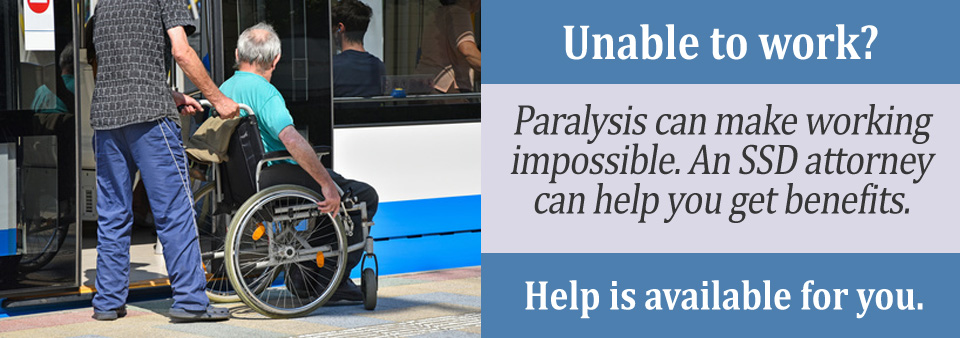Approximately 5.4 million Americans are currently living with some form of paralysis. There are many different conditions and injuries can that lead to paralysis, and they all might affect your ability to work differently.
While some people may suffer life-threatening complications related to paralysis, others may go on to lead productive, full lives.
If you have been paralyzed and are unable to work to your full capacity, there could be financial help available to you. The Social Security Disability Insurance (SSDI) program was created to assist those who have become disabled due to a health issue such as paralysis.
What Exactly is Paralysis?
Paralysis is the loss of muscle function in some part of your body. More often than not, it is accompanied by a loss of feeling to the affected area as well.
Paralysis can be temporary or permanent. It can also be partial or complete. With partial paralysis, you may be able to have some control over the muscles. Below are four well-recognized types of paralysis:
- Monoplegia: When paralysis occurs in one limb, such as the arm
- Hemiplegia: When paralysis occurs on one side of the body
- Paraplegia: When paralysis occurs in the bottom half of the body only
- Quadriplegia: When someone suffers paralysis from the neck down
The four most common causes of paralysis are stroke, head injury, multiple sclerosis, and spinal cord injury due to trauma. The most common causes of spinal cord injuries include car accidents, accidents while working, accidents during sports or outdoor activities, and falls.
Paralysis can also be caused by illnesses such as cerebral palsy, Lou Gehrig’s disease, and birth defects.
Paralysis can result in several other secondary health issues as well. For example, it may lead to problems regulating blood pressure, breathing difficulties or pneumonia, pressure ulcers, bladder and bowel issues, and blood clots. In some cases, it can cause a life-threatening emergency called autonomic dysreflexia.
Depending on the cause of paralysis, some people may regain function. However, there is no cure for permanent paralysis. In many cases, helping someone access accommodations to live with their disability is the most that can be offered.

What Symptoms Do I Need to Qualify?
Those who experience paralysis may face a broad range of symptoms that affect the ability to ambulate effectively. The Social Security Administration (SSA) lists the criteria for disability benefits in the Social Security Blue Book. Here are some signs that you might qualify for financial assistance from the SSA for your paralysis:
- If you have had a complete loss of function of any part of your body it will be difficult to work. The SSA requires that this loss of function last for at least three months before considering your application.
- Some people with paralysis have challenges moving from a seated position to standing. For many of us, our jobs require us to go from sitting to standing.
- You may experience difficulty with balance when walking or standing. For some with paralysis, walking and standing are not possible. If your job demands that you stand or walk, you may experience challenges continuing your job.
- Those with paralysis may have difficulty coordinating movement of the hands and fingers, such as difficulty answering a phone or typing. If your job requires that you use your hands, this may prove difficult if your paralysis affects your hands.
- If you are paralyzed, you may suffer from mental impairments as well. It is possible to experience difficulty interacting with others, understanding information, or concentrating. Since most jobs require communication and focus, working may prove difficult for you.
- As noted above, paralysis can affect many other body systems. If your paralysis results in injury to any other body systems, you may qualify for assistance. For example, if you have difficulty breathing due to your paralysis, the SSA will evaluate your case using the respiratory section of the Blue Book.
- Paralysis can cause anxiety and depression, which may impact your ability to work. If you experience emotional difficulty as a result of your illness, this may be considered in your application.
Do I Qualify for Social Security Benefits?
To be eligible for Social Security benefits, your medical records will need to show that the symptoms of your paralysis have been present for at least three months and that they are severe enough to prevent you from working at a level that would support you.
Additionally, your paralysis needs to be expected to last for at least 12 months. For most paralyzed people, this will be the case.
What Information Will I Need to Provide?
When applying for Social Security for your paralysis, you may be asked to provide the following:
- Confirmation of your diagnosis from your doctor
- X-rays, MRIs, CT scans, or other imaging results
- Electromyography (EMG) or Somatosensory Evoked Potential (SSEP) results, if performed
- Blood and urine tests, especially if you are experiencing other health problems secondary to your paralysis
- Notes from your doctor, physical therapist, or other health care provider that describe your symptoms and prognosis
If you are missing any of the above information, contact your doctor or hospital immediately. The more medical evidence that you have on your side, the better your chances of receiving SSDI benefits for your paralysis.
What’s Next?
If you are paralyzed and believe that you may qualify for Social Security benefits, you should contact a disability advocate or lawyer in your area. Losing function or feeling in any part of your body is life-changing.
When your health is suffering, it can be difficult to know where to turn or what to do next. A qualified attorney can help you navigate the Social Security application process, leaving you time to focus on what’s most important: your health.